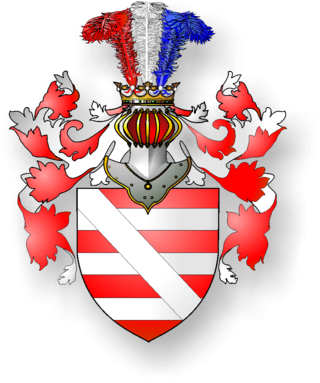
The Czartoryski coat of arms is a Polish–Lithuanian coat of arms, a variant of the Pogoń Litewska arms. It has been used by the Gediminid Czartoryski family.

Marie Casimire Louise de La Grange d'Arquien, known also by the diminutive form "Marysieńka", was a French noblewoman who became the queen consort of Poland and grand duchess consort of Lithuania from 1674 to 1696 by her marriage to King and Grand Duke John III Sobieski of the Polish–Lithuanian Commonwealth. She had great influence upon the affairs of state with the approval of her spouse, and acted in effect as regent during his absence.
Sobieski is a Polish noble family name, and may refer to:

Brest Litovsk Voivodeship was a unit of administrative territorial division and a seat of local government (voivode) within the Grand Duchy of Lithuania since 1566 until the May Constitution in 1791, and from 1791 to 1795 as a voivodeship in Poland. It was constituted from Brest-Litovsk and Pinsk counties.

Prince Michał Serwacy Wiśniowiecki was a Lithuanian nobleman, magnate, politician, diplomat, general, a successful military commander and the last male representative of the Wiśniowiecki family.

Prince Aleksander Ludwik Radziwiłł was a Polish–Lithuanian nobleman.
Katarzyna Eugenia Skumin Tyszkiewicz was a Polish noblewoman.

The House of Pac or Pacowie was one of the most influential noble families in the Grand Duchy of Lithuania during the era of the Polish–Lithuanian Commonwealth. Numerous high-ranking officials of the Commonwealth came from their ranks. Their coat of arms was Gozdawa.
Konstanty is a Polish-language given name and a surname, a variant of Constantine. Notable people with the name include:
Samuel Ludwik Zasadius or Zasadyus, Sassadius was a Polish religious writer, pastor and author of popular sermons and prayer-books. He was also known for propagating Polishness in Cieszyn Silesia.

Michael Rohoza was the Metropolitan of Kyiv, Galicia and all Rus' in the Patriarchate of Constantinople of the Eastern Orthodox Church from 1588 to 1596. In 1595, he signed the Union of Brest which moved the metropolis from the ecclesiastical jurisdiction of the Patriarchate of Constantinople to the jurisdiction of the Holy See. By this act, the Ruthenian Uniate Church was formed in the territory of the Polish–Lithuanian Commonwealth. From 1596 until his death in 1599, he held the title of "Metropolitan of Kyiv, Galicia and all Ruthenia" in the Ruthenian Uniate Church.

Hypatius Pociej, Polish: Hipacy Pociej, Ukrainian: Іпатій Потій) was the "Metropolitan of Kiev, Galicia and all Ruthenia" in the Ruthenian Uniate Church — a sui juris Eastern Catholic Church in full communion with the Holy See. He reigned from 1599 to his death in 1613. He played an active role in the 1595 Union of Brest of which he was a firm supporter. He was also a writer, polemist and theologian.

Jan Kanty Moszyński was a Polish-Lithuanian nobleman and politician, Treasurer of the Crown Court from 1729. He came from a poor noble family but married the daughter of Augustus II the Strong. His grandfather was Andrzej Ludwik Moszyński. His father, Aleksander Michał, lived in a small village in Podlasie and served as its treasurer. He was awarded the Order of White Eagle on 18 February 1730. Moszyński and more so his son Frederyk August Moszyński (1739–1786) built a notable museum collection.

Konstanty Ludwik Plater, was Castellan of Troki from 1770, voivode of Mstislavl from 1758 to 1770, Castellan of Polotsk from 1754 to 1758, the great Lithuanian Magnus Scriptor from 1746 to 1754, Maréchal of the Lithuanian Tribunal in 1754, and Starosta of Livonia and Dyneburg. In 1754, he was awarded with the Order of White Eagle, Knight of the Order of Saint Stanislaus, and the Russian Order of St. Alexander Nevsky. He married Countess Augustina Oginska on 16 August 1744.
The Battle of Vilnius took place on 16 April 1702 in Vilnius, the capital of the Grand Duchy of Lithuania, during the Great Northern War.
The Eparchy of Volodymyr–Brest was an eparchy of the Ruthenian Uniate Church from 1596 until 1795. It was situated in the Polish–Lithuanian Commonwealth between the rivers Bug and Styr on territory that is today located in parts of the modern states of Ukraine and Belarus. The eparchy was a suffragan of the Metropolis of Kiev, Galicia and all Ruthenia.
Królewicz was the title given to the sons and daughters of the king of Poland, later the Polish–Lithuanian Commonwealth. It was similar in its distinctiveness to the Spanish and Portuguese title of infante, also reserved to the children of the monarch. Though, it was used only to denote one's status as a King's child. Królewicz and królewna has no direct equivalent in other languages and was translated to the English prince and German Prinz, like dynasts of a royal house. Królewicze since the 16th century could not also be regarded as and equivalent to the princes of the blood, because the Polish monarchy was not hereditary since 1573, when after the death of the last Jagiellon king, future Henry III of France was elected. In official Latin titulature children of Polish kings were often styled as Poloniae princeps or princeps Poloniae, meaning Prince/ss of Poland or Polish prince/ss. In more official way, the full style of sons of monarchs was Dei Gratia regius princeps Poloniae et Lithuaniae for the sons.
Pociej is a surname. Notable people with this surname include:

The Plater family is a German noble family originating from Westphalia, whose members first settled in Livonia and later in Lithuania and Poland.











